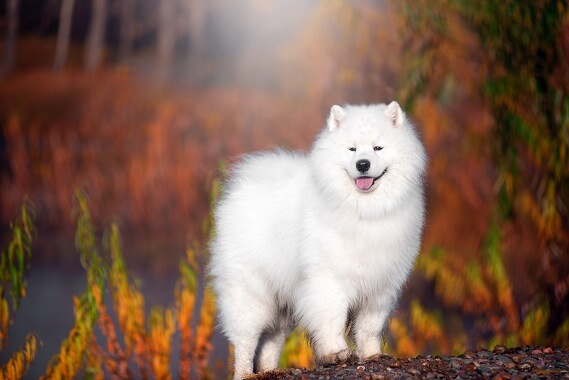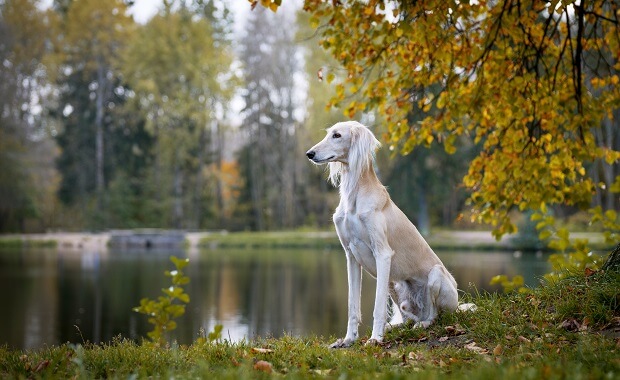
The Samoyed is a breed of working dog that was bred to pull sleds and herd animals in some of the coldest conditions. This dog is originally from northern Russia and it got its name from the Samoyedic peoples of Siberia with which it worked. These dogs worked closely with the tribe and shared their tents so the have a fond love of family life. The Samoyed is a medium-sized dog that has Nordic heritage. It is a Spitz breed and has several typical characteristics of this type of dog, including erect pricked ears and a tail that curls over its back. They are white in color and they have a medium length double-layered coat. Their coat is weather-resistant and enables them to work in temperatures that get as cold as – 60 degrees celsius! Samoyeds have several characteristics that make them suited for very cold weather, including their big, flat feet that have hair between the toes and on the pads. Their feet are like snowshoes, enabling the dogs to move easily through their environment. The hair on their feet also prevents snow from clumping to them and hampering their working ability. Aside from herding animals, these dogs have also been used by explorers. In the early 1900s, these dogs accompanied explorers to the polar regions. After the expeditions were over, many of the dogs returned home with the explorers. Mr. and Mrs. Kilburn-Scott, for example, first introduced the Samoyed into the UK after they saw them in their native country in 1889. They quickly become popular household members and are still popular to this day. Samoyeds have an independent personality that can make them difficult to train. They are social, playful, and have endless amounts of energy so they require a good amount of exercise. These dogs are known for being gentle and are great with children, making them the perfect family pet. Samoyeds have a high pitch bark that can be intense and annoying. They are also extremely vocal. These dogs should never be left alone outside for long periods of time. Fun Facts about the Samoyed! This fluffy dog’s personality is as big as its coat and it makes an excellent companion for someone who can handle a headstrong dog. Known for their smiling face, Samoyeds are one of the ancient dog breeds and they have worked with tribes for centuries, helping them to herd animals and to pull sleds. Their biology makes them perfectly adapted for life in the cold. There are several fun facts about these dogs, let’s take a look at some of them! The Samoyed dog breed was bred in Siberia some 3,000 years ago, and this breed is one of the 14 ancient dog breeds. Their genetic footprint is closer to wolves than other dogs species. This breed gets its name from the nomadic Samoyedic peoples of Siberia, who used this dog to herd reindeer, hunt, and pull sleds. DNA analyzes demonstrate that the Samoyed along with 13 other species are the most ancient of dogs and show the fewest genetic differences from wolves. It is hypothesized that the early pariah dogs in Asia evolved from the grey wolf. The pariah dogs then migrated with nomadic human groups as far as Africa and the arctic. The fourteen ancient breeds originated in the Middle East, China, Tibet, Japan, Central Africa, and the Arctic. They are: While some dogs can have a repugnant odor, Samoyeds are known for being odorless and if their grooming is kept up to a high standard then they require very little bathing. This characteristic is a favorable one for people who don’t like a doggy smell in their house. The Samoyed has a double coat that is strong and warm. The color of its coat is white, cream, or white with light brown highlights and the tips of the outer hair can have a silver shine to it. The samoyed’s outer coat is long and coarse. The coat stands out from its body, giving them a big, fluffy appearance. The undercoat is made of wool and can be used in clothing. The wool is not sheared like sheep though, it is collected when the Samoyeds shed and, once spun, it can be woven or knitted into fabric. The females usually shed twice a year whereas the males will only shed once. These dogs shed their entire coat which means that there is a lot of hair around when they shed. However, this is only a problem for a short time as once they have completed their shedding and the new coat grows they shed very little. Samoyeds have retained some of the characteristics associated with wild dogs, such as wolves, and as such, they are pack animals by nature. This means that these dogs don’t do well by themselves. As pack animals, these dogs also need to know who the alpha dog is so that they have a leader. To avoid problems with them at home, these dogs must recognize their owners as the alpha dog, or the pack leader to ensure that they are obedient.
Kingdom
Animalia
Phylum
Chordata
Class
Mammalia
Order
Carnivora
Family
Canidae
Genus
Canis
Species
Canis lupus
Subspecies
Canis lupus familiaris
Height
19 – 23.5 inches (48.3 – 59.7 cm)
Weight
50 – 60 lbs (22.7 – 27.2 kg)
Lifespan
12 – 14 years
Social Structure
Domesticated, herding dog
Status
Least concern
Natural Habitat
Domesticated
Average Litter Size
5 – 9 puppies
Main food item
Dog food
Potential predators
Few predators
The Basics

Ancient Dog Breed

Odorless Dogs

Pack Living
